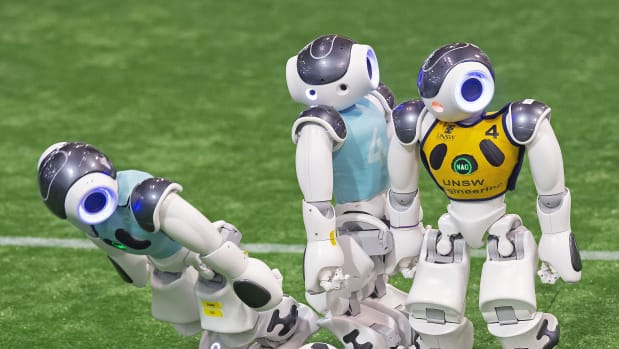Fifteen international teams from Australia, Brazil, China, Germany, Iran, Japan and Portugal recently descended on Sydney for the 2019 RoboCup Millennium Challenge. Eleven fully autonomous virtual robots known as “agents” played as part of each team without the assistance of a remote control and complying with FIFA rules. The nail-biting final came down to the wire, with an Australian team emerging victorious over the 2018 world champions with seconds to spare. But this was more than a game, it highlighted Australia’s strengths in robotics and the speed with which the field is evolving.
According to IDC the global robotics market was worth $151 billion in 2018, and that's expected to double to $315.5 billion by 2021. Robots are used today in wide-ranging fields such as precision agriculture, mining, medical procedures, construction, biosecurity, transportation and even for companionship. Advancements in robotics have been accompanied by a fear that robots and automation will take our jobs along the way. While there are short-term risks with forecasts of 40 per cent of jobs potentially being displaced, it’s not clear that there will be an overall reduction in the number of jobs over time[Link will open in a new window]. The World Economic Forum suggests that the opposite will occur. In their Future of Jobs 2018 report, the authors concluded that while automation technologies including artificial intelligence could see 75 million jobs displaced globally, 133 million new roles may emerge as companies shake up their division of labour between humans and machines, translating to an additional 58 million new jobs created by 2022. A recent report by AlphaBeta estimates that automation can boost Australia’s productivity and national income by (up to) $2.2 trillion by 2030 and result in improved health and safety, the development of new products and services, new types of jobs and new business models. In that same report AlphaBeta concluded that by 2025 automation in manufacturing could increase by 6 per cent along with an 11 per cent reduction in injuries while wages for non-automatable tasks will rise 20 per cent.
The key to unlocking economic and societal benefit from robotics will be to have them do things not possible or economic before. Take caring of an ageing population that is forecast to live longer but with a smaller workforce to support them. The math doesn’t add up without new methods for care to keep people out of hospitals and in their homes longer. Or supporting children with autism to develop social interaction and communication skills with Kaspar, a social robot being trialled by researchers at the University of New South and CSIRO. Robots can help with dangerous jobs too. CSIRO’s Data61 spinout Emesent develops drones capable of travelling in GPS-denied environments utilising 3D LiDAR technology. They travel down mineshafts to safely inspect hard to access areas of underground mines, so people don’t have to. On the other side of the world, a Harvard University group has spent the last 12 years creating a robotic bee capable of partially untethered flight powered by artificial muscles beating the wings 120 times a second. The ultimate objective of the program is to create a robobee swarm for use in natural disasters and artificial pollination given the devastating effectives of colony collapse disorder on bee populations and consequently food pollination. The US Department of Agriculture estimates that of the 1400 crops grown for food, 80 per cent depend on pollination and globally pollination services are likely worth more than $3 trillion. Advancement in robotics is accelerating. They will increasingly evolve from isolated machines to be seamlessly integrated with our environments and each other. When one robot encounters an obstacle or new context and learns, the entire network of robots can instantaneously learn. Other advancements include the use of more tactile skins with embedded pressure sensors, and more flexible sensors. A team of engineers from the university of Delaware have created flexible carbon nanotube coatings on fibres that include cotton and wool, resulting in shape forming, flexible and pressure sensitive skins. Just as with the robobee there are also advancements in collaborative robots, or cobots, that can be used for resilient search and rescue operations among other things. We are also witnessing improvements in dexterity. The California-based Intuitive Surgical has developed a robot allowing a surgeon to control three fully articulated instruments to treat deep-seated damaged or diseased tissues or organs. Robots are also being developed that can unfold and soft robotics that will be important for applications that involve people contact.
The challenge until recently has been a lack of actuators or artificial muscles that can replicate the versatility of real muscles. Advancements are being made with one design made from inexpensive materials reportedly able to lift 200 times its weight. Another compelling advancement is in augmenting our own muscles via wearable robots or exoskeletons. Applications today range from helping prevent workplace injury to helping people function more fully after spinal cord damage or strokes. Australia can benefit substantially from robotics in areas like managing environmental threats, maintaining vital urban infrastructure, maximise crop yields in drought-affected regions, transportation or supporting law enforcement. Australia was the first country to automate its ports and mine sites and we have strong university capabilities at QUT and Sydney University among others. Today there are about 1100 robotics companies in the country and CSIRO’s Data61 recently opened the largest robotic motion-capture facility in the southern hemisphere. The question of how Australia can capitalise on the trillion-dollar artificial intelligence and robotics revolution will be the focal point of the upcoming D61+LIVE[Link will open in a new window] conference in Sydney this October. Like all other industry creation opportunities in front of us right now, the opportunity is perishable and the way to maximise the benefit as a country is to be a global leader in parts. The Australian Robocup team has shown us how it’s done. Game on. Adrian Turner is the outgoing CEO at Data61 and co-chair of AustCyber.Unlocking economic value
Robotic advancements


